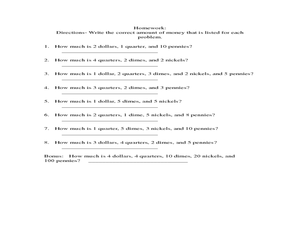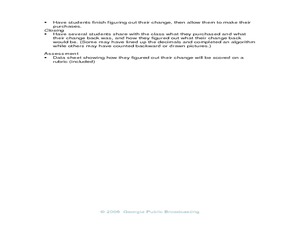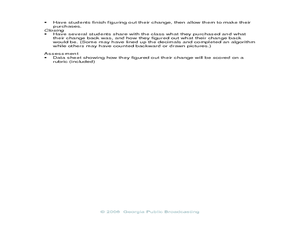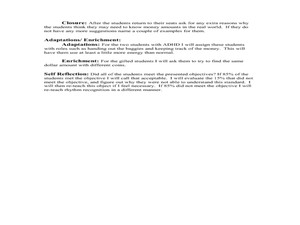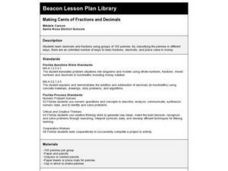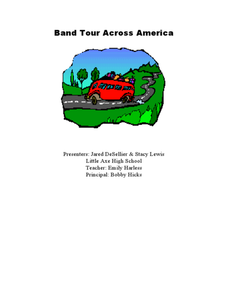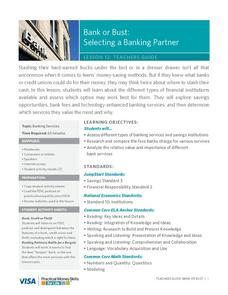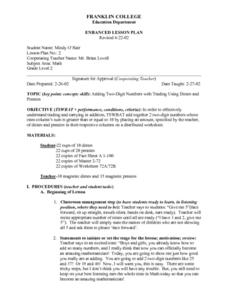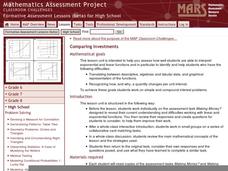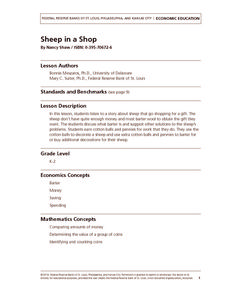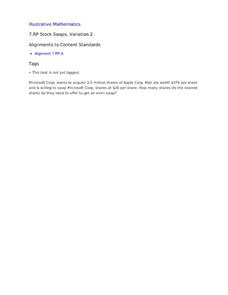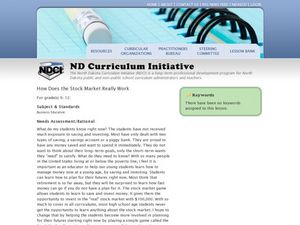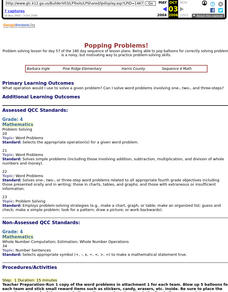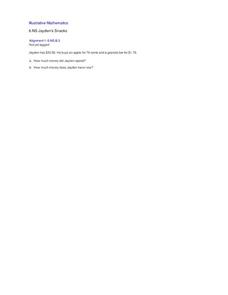Curated OER
Let's Find Out About Money
First graders investigate the uses and development of money as part of the study of finance. They focus upon the recognition of different coins and identify the value of each. Then students solve problems involving money and coins.
Curated OER
How Much Money Do You Have?
Second graders are given 8 world problems dealing with an assortment of coins. In this money lesson plan, 2nd graders determine the answers to each problem with 100% accuracy. Students complete a worksheet that is graded.
Curated OER
Spending - Maintaining the skill of money
Third graders practice making change with money. For this subtraction lesson, 3rd graders watch a video about money. Students investigate what it means to earn money, spend it, and find their change.
Curated OER
SPENDING: Maintaining the Skill of Money
Fourth graders explore the concept of maintaining money. In this personal finance lesson, 4th graders earn "money" for cleaning their classroom desks. Students spend the "money" in the classroom and practice making change.
Curated OER
Making Amounts with Money
Second graders discuss how to make correct change. In this lesson plan on money, 2nd graders practice making an amount using the correct number of coins.
Curated OER
Making Cents of Fractions and Decimals
Students explore decimals and fractions using groups of 100 pennies. By classifying the pennies in different ways, there are an unlimited number of ways to learn fractions, decimals, and place value in money. This is a good, hands-on...
American Statistical Association
Exploring Geometric Probabilities with Buffon’s Coin Problem
Scholars create and perform experiments attempting to answer Buffon's Coin problem. They discover the relationships between geometry and probability, empirical and theoretical probabilities, and area of a circle and square.
Curated OER
Band Tour Across America
Students plan the trip of a band across America. In this money planning lesson, students create a budget for the band using excel basic functions. They manage the band and its budget and relate the tour to future budgeting needs of the...
Visa
Bank or Bust: Selecting a Banking Partner
Why shouldn't we just save all our money in our mattress? Couldn't our money disappear? Pupils discover the benefits of utilizing banks and credit unions for saving money, as well as how to evaluate different types of...
Visa
Make It Happen: Saving for a Rainy Day
Every little penny counts, especially when it comes to saving for emergencies or long-term goals. Pupils evaluate different saving and investment strategies, such as a CD or money market account, through worksheets and by...
Curated OER
A Trip to the Toy Store
First graders recognize and identify the value of a penny, nickel and dime. They spend play money in a simulated toy store and match their coins to the purchase price of a toy of their choice.
Curated OER
The Dollar Cookie
Second graders recognize, count, and write money amounts using the cent symbol and identify equivalent amounts of money. In this money lesson plan, 2nd graders add money amounts using plastic coins and magnetic money.
Curated OER
The Big Buck Adventure: Part 2
Students go on a pretend shopping spree. In this money instructional activity, students complete a Shopping Spree activity sheet where they pretend they have won $100 and can spend it on a fake shopping spree. Students use...
Curated OER
Adding Two Digit Numbers with Using Dimes and Pennies
Second graders participate in a math game using dimes and pennies. They practice combining coins to make a given amount of money, and they use the combinations to practice adding two digit numbers. Teacher assessment strategies and...
Curated OER
Comparing Investments
Money, money, money. A complete lesson that makes use of different representations of simple and compound interest, including written scenarios, tables, graphs, and equations to highlight similarities and differences between linear and...
Federal Reserve Bank
Less Than Zero
Perry the penguin wants to buy a new scooter, but he doesn't have any funds! Walk your kids through the short book Less Than Zero, and have them track his borrowing, spending, and saving on a line graph while you read. Pupils will learn...
Federal Reserve Bank
Sheep in a Shop
What do you think sheep might be able to barter when they don't have quite enough to buy a gift? Your pupils can find out this and much more during this lesson about Sheep in a Shop, spending, saving, and bartering.
Mathematics Assessment Project
Estimating Length Using Scientific Notation
Would you rather have a million dollars or 1 x 10^6 dollars? To find the answer to this question, class members first complete an assessment task converting numbers between decimal notation and scientific notation. They then take...
Curated OER
Stock Swaps, Variation 2
If Microsoft wanted to take over Apple, how many shares would they need to break even? This is an ideal task for seventh graders who are studying proportional relationships and applying them to real-world scenarios. Use it as an...
Curated OER
How Does the Stock Market Really Work?
Investigate the stock market as it relates to the business world. Young scholars investigate ways to invest their money for the future. They make a presentation and discuss their findings with the class.
Curated OER
Popping Problems!
Turn your math lesson into a carnival game with this fun, outdoor activity. After reviewing the concept your class will be practicing briefly, split your class up into teams and head outdoors. These teams work to solve math questions and...
Illustrative Mathematics
Jayden’s Snacks
A quick activity to test the knowledge of your learners on adding and subtracting with decimals. They must calculate how much Jayden spent at the store and how much money he has remaining.
Curated OER
Linear or Exponential?
Your learners analyze various real-life contexts to decide if each is a linear or exponential model. This could be used as an assessment of learners' skills of discerning between a linear and an exponential model.
Illustrative Mathematics
Heads or Tails
Heads! A great way to practice probability is to flip a coin in class. The provided data allows your mathematicians to predict the probability of heads in ten coin flips. Bring coins to class and allow your own trial of heads or tails....

